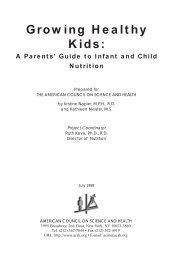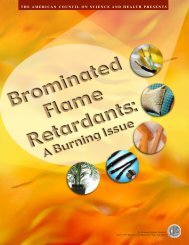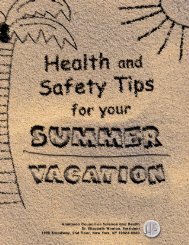Health and Safety Tips for Your Summer Vacation (Update 2010)
Health and Safety Tips for Your Summer Vacation (Update 2010)
Health and Safety Tips for Your Summer Vacation (Update 2010)
You also want an ePaper? Increase the reach of your titles
YUMPU automatically turns print PDFs into web optimized ePapers that Google loves.
• Wear protective clothing—long sleeves <strong>and</strong><br />
pants—<strong>and</strong> be careful when removing clothes<br />
so that plant resin doesn’t contact the skin.<br />
• Wash thoroughly with soap <strong>and</strong> water after<br />
hiking in an affected area.<br />
• Watch where you sit!<br />
Overheating in the <strong>Summer</strong> Sun<br />
Very hot <strong>and</strong> humid weather causes an increase<br />
in internal body temperature, which places greater<br />
dem<strong>and</strong>s upon the body’s cooling mechanisms.<br />
There is a limit beyond which these mechanisms<br />
can no longer maintain a normal internal temperature<br />
of 98.6 degrees Fahrenheit. If body temperature<br />
continues to rise without sufficient cooling, a serious<br />
heat disorder can occur. Those people particularly<br />
at risk are:<br />
• Workers in hot environments, especially if the<br />
job requires physical labor<br />
• Athletes <strong>and</strong> frequent exercisers<br />
• Infants, young children, <strong>and</strong> elderly people<br />
• The chronically ill, <strong>and</strong> people with heart or circulatory<br />
problems<br />
• Alcoholics, drug abusers<br />
Heat disorders can be mild or severe:<br />
Heat rash - While not life-threatening, heat rash can<br />
certainly interfere with vacation fun. In hot, humid<br />
environments, sweat cannot evaporate easily, leading<br />
to plugged sweat gl<strong>and</strong>s <strong>and</strong> a consequent skin<br />
rash. The rash can be treated by cool showers <strong>and</strong><br />
cornstarch-containing powders. To prevent heat<br />
rash, keep the skin dry <strong>and</strong> wear fast-drying clothing.<br />
Heat fatigue - Characterized by discom<strong>for</strong>t, irritability,<br />
disorientation, headaches, <strong>and</strong> fatigue, this<br />
mild disorder can be alleviated by getting out of the<br />
heat, relaxing, <strong>and</strong> drinking plenty of cool liquids.<br />
Heat cramps - Physical activity in a hot environment<br />
can cause these painful muscle spasms.<br />
Massage the affected muscles <strong>and</strong> drink both water<br />
<strong>and</strong> electrolyte replacement drinks, as cramps are<br />
indicative of an imbalance in the body’s normal<br />
fluid <strong>and</strong> salt content.<br />
Heat syncope/fainting - Those unused to hot<br />
environments, or who are active <strong>for</strong> long periods<br />
in the heat, may experience such a reduced blood<br />
flow to the brain that fainting results. Fainting<br />
victims should lie down <strong>and</strong> rest in a cool place,<br />
<strong>and</strong> drink plenty of fluids.<br />
Heat exhaustion - Heat exhaustion is a more serious<br />
loss of body fluids <strong>and</strong> salt, <strong>and</strong> decreased<br />
blood flow to the brain <strong>and</strong> other organs, which<br />
can lead to symptoms such as excessive sweating;<br />
cool, pale, <strong>and</strong> clammy skin; weakness;<br />
nausea, headache, dizziness; <strong>and</strong> slightly elevated<br />
body temperature. Victims of heat exhaustion<br />
should be moved to a cool place to rest with their<br />
feet slightly elevated <strong>and</strong> their clothes loosened<br />
or removed, <strong>and</strong> they should drink plenty of cool<br />
liquids.<br />
Heat stroke - The most serious of heat disorders,<br />
heat stroke is the result of a complete breakdown<br />
of the body’s cooling mechanisms. Symptoms<br />
include lack of perspiration; red, bluish, or mottled<br />
skin; hot <strong>and</strong> dry skin; strong, rapid pulse;<br />
temperature of 105 degrees Fahrenheit or higher;<br />
severe headache, chills, or nausea; mental confusion,<br />
dizziness; unconsciousness, convulsions,<br />
<strong>and</strong> eventual coma. Heat stroke should be treated<br />
immediately because it can cause brain damage<br />
<strong>and</strong> death. Call <strong>for</strong> emergency help, then remove<br />
the victim’s clothing <strong>and</strong> cool the body by rubbing<br />
with a cold sponge or ice pack, cold compresses,<br />
a fan, or by immersing in tepid water.<br />
<strong>Tips</strong> to Beat the <strong>Summer</strong> Heat<br />
• Pay attention to weather reports <strong>and</strong> adjust<br />
daily routines accordingly.<br />
• Schedule physically strenuous activities <strong>for</strong><br />
cooler times.<br />
• Allow several days to adjust to hot environments.<br />
• Dress in light, loose, cotton clothing. Widebrimmed<br />
hats help keep you cool as well.<br />
• When working outside, take periodic rest<br />
breaks in a cool area.<br />
• Drink plenty of noncarbonated fluids be<strong>for</strong>e,<br />
during, <strong>and</strong> after physical activities. Avoid<br />
8










